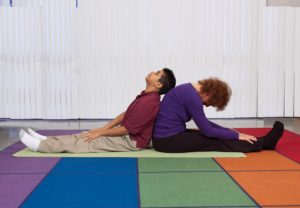Yoga helps special needs children find comfort in their skins
By Nancy B. Loughlin
Whether you’re a parent or a teacher, day-to-day interaction with a special needs child is perplexing.
Regardless of a diagnosis of a neurodevelopmental disorder, physical disability or impulse-control disorder/conduct disorder, the goal is to help the child have a better awareness of and handle on his or her own body.
Enter yoga as a therapeutic device.
Yoga helps children with special needs become reflective of their own states of mind. Caregivers could remember that special-needs kids have loads of stress among other sensory and attention issues. Without tools to self-regulate their own behavior, focus, motor planning, anxiety, sleep patterns and self-esteem are formidable foes.
Special needs children are disconnected from their bodies. Yoga offers practice in piloting through a world of distractions in order to calm and focus the mind. The body awareness activities combined with the breath work will activate the calming parasympathetic nervous system, an essential tool for kids with low tolerance for frustration.
It’s through yoga play (not a yoga class) that kids get the sensory input they need (movement, touch and stimulation) while practicing the body awareness tools. Kids play with poses that develop focus, balance and strength. Once kids establish a routine, they can become aware of their body states and make different choices.
According to Louise Goldberg, author of Yoga Therapy for Children with Autism and Special Needs (2013), helping such children begins with the principles of creative relaxation.
“It’s about meeting kids where they are,” she said. The experience begins with establishing a sacred space for the kids.
“The environment has to be as spare and free as possible,” she said. Kids with special needs require consistency. They need to know how long the class is going to last. They need a set schedule and a familiarity with the routine. Next, the yogic experience must be safe. There are certain poses some kids cannot do, particularly inversions for kids prone to seizures.
“It’s all about becoming an astute observer of the kids you’re working with,” Goldberg said.
When a child’s breath becomes shallow and quick, the voice rises in pitch while fists, faces and shoulders tense, kids can be cued to several yogic relaxation tools (named especially for kids):
Autism: To soothe the central nervous system, kids can sit and circle the torso or Rock the Baby.
Physical disabilities: Goldberg teaches kids with limited mobility to regulate respiration and calm the mind with Tree Breathing. The child can lie down or sit, inhale while raising the hands upward and exhale as arms fall.
Down syndrome: To help the child turn attention inward, Goldberg recommends Folded Leaf for highly flexible children. While seated on the floor with the legs stretched long, the child forward folds and holds, imagining the wind on his or her back.
Mood disorders: Rag Doll is an easy pose without requiring a child to move out of his or her space. The forward fold is calming, and the inversion is an opportunity to let go and sway.
Attention deficit hyperactivity disorder (ADHD): Stretching Dog (otherwise known as Downward-Facing Dog) requires a child to be observant of hands, feet, back, legs and shoulders. All this brings the focus into the body, and the inverted posture soothes the child.
Sensory processing disorder: Drawbridge is a good posture for feeling grounded through the back and feet as well as the hands and head. Elevating the pelvis is believed to trigger the vagus nerve and calm the body.
All of Goldberg’s students find Baby a soothing posture. As the child sits back on the heels and folds over the knees, ocular pressure triggers the quieting reflexes of the brain. Yet, Goldberg’s favorite is Huh Breath. The child lifts the shoulders on the inhale, and on the exhale, the shoulders drop with an audible “huh.”
Perhaps these would be soothing for caregivers, teachers and parents, too.
Visit yogaforspecialneeds.com for more information.

